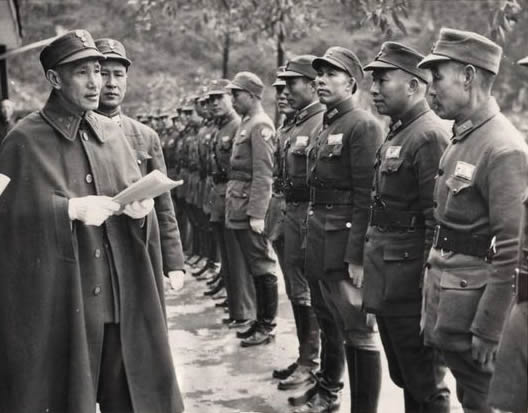 |
| Chiang Kai-shek |
Chiang's proper name was Chung-cheng, but he is better known by his courtesy name, Kai-shek. The son of gentry parents from Fenghua in Zhejiang (Chekiang) Province, Chiang was raised by a widowed mother, graduated from the first class of Paoting Military Academy, and then studied in a Japanese military school, where he joined Dr. Sun Yat-sen's revolutionary movement, later called the Kuomintang (KMT, or Nationalist Party [Guomindang]), in 1911.
It became his lifelong cause. He fought in the wars that overthrew the Manchu Qing (Ch'ing) dynasty in 1911 and with Sun out of power in 1912, became a businessman in Shanghai.
In 1922 Chiang answered Sun's call in Canton. Sun sent him to the Soviet Union in 1923, where he spent three months studying Red Army techniques and in talks with Leon Trotsky (father of the Soviet Red Army). This trip made him deeply suspicious of Soviet intentions in China.
  |
Back in China he founded the Whampoa Military Academy, which trained officers in Sun's Three People's Principles and in modern military techniques. In 1926 Chiang led the Northern Expedition to unite China under the Kuomintang.
His rapid victories led to the capture of southern China and the Yangzi (Yangtze) River valley by 1927, whereupon he broke with the Soviet Union, expelled its advisers, and purged the KMT of its left-wing elements, led by Wang Jingwei, and their Chinese Communist Party (CCP) allies. By 1928 Chiang's forces had captured Beijing (Peking). Defeated warlords and those facing defeat promised to obey the KMT, and China was unified, at least nominally.
 |
| Chiang's wife Song Meiling, and Gen. Joseph Stilwell. |
The KMT-led National Government established its capital at Nanjing (Nanking), where for the next decade Chiang led China's first modern government, whose major nation-building projects included roads and railroads, modern schools, new law codes that made women equal, industries, and the military.
Chiang and his government were challenged by three enemies: the remaining warlords and his rival generals in the KMT, whom he partly succeeded in taming; the CCP, which established a Chinese Soviet Republic in Jiangxi (Kiangsi) province in southern China (Chiang defeated but did not eliminate them in the encirclement campaigns and the Long March); and Japan, which sought to seize Chinese territories beginning with the Manchurian incident in 1931 and culminating in the Marco Polo Bridge incident in 1937, which led to eight years of war that became part of World War II.
   |
Chiang led China in an exhausting war in which Japan occupied the coast but could not conquer China. China's role in World War II led to its recognition as a leading Allied power. It was a founding member of the United Nations and a permanent member of the Security Council.
However, victory came at a heavy price. China's economy was ruined, tens of millions of refugees awaited resettlement, and Chiang's troops were exhausted. War vastly expanded the CCP's power, from 30,000 troops in 1937 to 3 million in 1945.
 |
| Chiang Kai-Shek inspecting Chinese troops |
The CCP refused to participate in a constitutional process initiated by the KMT, and civil war broke out between the KMT and CCP forces in 1946. Chiang resigned as president of China in 1948, and all China came under CCP control in 1949. Remnant KMT forces rallied behind Chiang on Taiwan in 1949, and Chiang resumed his presidency in 1950 and continued to serve until he died in 1975.
Chiang's government undertook land reforms and successful economic measures on Taiwan with U.S. economic and military aid. By 1975 it was well on its way to the success that made it one of the "Four Tigers" of Asia.
 |
| Statue of Chiang Kai-shek in Yangming Park, Taipei, Taiwan |